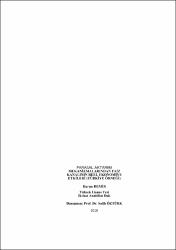| dc.contributor.author | Demir, Harun | |
| dc.date.accessioned | 2019-12-23T06:57:48Z | |
| dc.date.available | 2019-12-23T06:57:48Z | |
| dc.date.issued | 2018 | |
| dc.identifier.uri | https://hdl.handle.net/20.500.11776/3277 | |
| dc.description.abstract | Bu tez çalışmasının temel amacı, parasal aktarım mekanizması faiz oranı kanalının reel ekonomi ve enflasyon üzerindeki etkilerini Türkiye ekonomisi için 2006:M1-2018:M3 dönemini kapsayan aylık veriler ile test etmektir. Bu amaçla çalışmada kısa vadeli faiz oranı, reel uzun vadeli faiz oranı, sanayi üretim endeksi ve enflasyon değişkenleri ele alınarak iki farklı model oluşturulmuştur. Serilerin durağanlık derecelerinin tespiti için ADF ve PP birim kök testleri kullanılmıştır. Elde edilen birim kök test sonuçları değişkenler arasındaki uzun dönemli ilişkilerin tespitinde birinci model için Johansen Eşbütünleşme testi ve ikinci model için de ARDL sınır testinin kullanılmasına imkan vermektedir. Bu nedenle oluşturulan iki model için değişkenler arasındaki uzun dönemli ilişkilerin tespitinde Johansen eşbütünleşme testi ve ARDL sınır testi kullanılmıştır. Sonraki aşamada iki model için VAR analizi ile sonuçlar tahmin edilmiştir. Analiz sonucuna göre, Türkiye’de faizler ile reel ekonomi arasındaki ilişkiden elde edilen bulgular faiz oranı kanalının işleyişini tam olarak yansıtmamaktadır. Ayrıca enflasyon ve faiz oranları arasında ekonomi teorilerine uygun ve istatistiksel olarak anlamlı sonuçlara ulaşılmıştır. | en_US |
| dc.description.abstract | The main purpose of this thesis is to test the effect of the monetary transmission mechanism for the Turkish economy on the real economy and inflation, with monthly data covering the period 2006: M1-2018: M3. Variables used in the analysis are short term interest rate, real long term interest rate, industrial production index and inflation. Series stationarity was investigated by ADF and PP unit root tests. The obtained unit root test results allow to use the Johansen Cointegration test for the first model and the ARDL bounds test for the second model in determining long-term relationships between the variables. For this reason, the Johansen cointegration test and the ARDL bounds test were used to determine the long-term relationships between the variables. The results were estimated by VAR analysis for the two models in the next step. According to the results of the analysis, the findings obtained from the relationship between the real economy with interest rates in Turkey are not fully reflect the functioning of the interest rate channel. In addition, inflation and interest rates are in line with economic theories and statistically significant results have been achieved | en_US |
| dc.language.iso | tur | en_US |
| dc.publisher | Namık Kemal Üniversitesi | en_US |
| dc.rights | info:eu-repo/semantics/openAccess | en_US |
| dc.subject | Parasal Aktarım Mekanizması | en_US |
| dc.subject | Faiz Oranı Kanalı | en_US |
| dc.subject | Para Politikası | en_US |
| dc.subject | Johansen Eşbütünleşme Testi | en_US |
| dc.subject | ARDL Sınır Testi | en_US |
| dc.subject | VAR Model | en_US |
| dc.subject | Monetary Transmission Mechanism | en_US |
| dc.subject | Interest Rate Channel | en_US |
| dc.subject | Monetary Policy | en_US |
| dc.subject | Johansen Cointegration Test | en_US |
| dc.subject | ARDL Bounds Test | en_US |
| dc.title | Parasal aktarım mekanizmalarından faiz kanalının reel ekonomiye etkileri (Türkiye örneği) | en_US |
| dc.type | masterThesis | en_US |
| dc.department | Enstitüler, Sosyal Bilimler Enstitüsü, İktisat Ana Bilim Dalı | en_US |
| dc.relation.publicationcategory | Tez | en_US |



















